This post is part of a series of posts documenting my trip to Egypt. To read from the beginning, go to the
first post and follow the links at the bottom of each page.
Thursday, 26 November
The Sahara Desert is one huge piece of real estate. It constitutes a large percentage of Egypt’s one million square kilometers of territory and its power is rightly respected by anyone who has to venture across its sands. It’s one thing to zip across the space in an air conditioned vehicle at eighty kilometers per hours, and quite another to cross it on foot or astride a camel. That thought is constantly in mind as I look out across the area occupied by our encampment.
I took the train down to Cairo yesterday afternoon and stayed over with fellow Fulbrighter Zohair Husain, who is teaching at the University of Cairo. He hosted me once before and invited me to stay with him prior to leaving for the desert trip. We had a light dinner and then proceeded to prepare for three days living in a tent. For me, that meant emptying my backpack and piling everything I wouldn’t be needing on the spare bed in my bedroom. I took both a fleece and a jacket because we had been told that it would be cold at night. Other than that, just a couple changes of shirts, underwear and socks, my cap, the Blue Guide and a package of disinfectant wipes. At Ginger da Costa’s suggestion, I also took along a sheet pilfered from Zohair’s guest bed. Blankets, mattresses, food, and water were to be supplied by the expedition outfitters. Zohair was worried about toilet articles and being able to shower—he said he couldn’t sleep without a shower—but I told him that after the second day we’d all smell the same, so not to be concerned.
We awoke at six on Thursday morning, had a breakfast of eggs and fruit salad—“Eat it up,” says my host, piling another heaping mound of chopped apples, kiwi, pineapple, etc. in my bowl—“it’ll go off before we get back.” We set off for the rendezvous point with my stomach groaning from all the roughage. A short taxi ride across the Nile and north on the Corniche brings us to the building of the British Council, a three-story Empire-style stone building painted a rather un-Empire-ish yellow with white trim. Rather jolly for Cairo, actually. Ginger and Joelle are waiting for us with the news that Dominique was feeling unwell and had bailed out at the last minute. Before too long, a white eight-passenger van with “Badawiya Expeditions” painted on the side pulled up.
The driver and his assistant got out and proceeded to stow our bags in the rear. We got in and were told that we were awaiting the arrival of two more passengers. Ginger told the driver that one of the two would not be coming, so we were only one short of our full complement of riders.About ten minutes later, the final member of our troupe arrived. Jamie Balfour-Paul joined us and we learned that he had been serving as the regional director of Oxfam in Egypt for the past two years. Tall, soft-spoken, and affable, he quickly fitted in with the four of us. Just as we were about to set off, we were joined by two Egyptian women (a mother and daughter we later found out), who were friends of the owner of the expedition company and were spending the Eid with him in the Farafra Oasis. They piled in with their gear and we were off on our adventure, the driver’s assistant waving to us from the curb.

It took us an hour to clear the traffic and sprawl of Cairo and Giza, but finally we were on the road toward the Fayyoum and the desert beyond. Just north of the Fayyoum, we turned off to the west and headed out into the Sahara proper. [DSCN 0069] Greenery slowly dissipated; trees shriveled and disappeared; bushes grew increasingly emaciated and scrawny; grass, when there was any, grew in tufts and looked very coarse. Traffic dwindled to the occasional heavy truck and the rare automobile. The day was clear and not terribly hot; the two-lane macadam was relatively smooth. We traveled along a railway for quite a while, a line that served the few commercial ventures out here—mineral extraction, primarily. To the right, we saw occasional signs marking roads that led off even further into the desert. The signs read “Rig No. 49;” “Rigs No. 81 & 82.” These were oil derricks or pumping stations for wells so far off the main road that we couldn’t see them from the van.
Once every so often, we would pass a lone building standing adjacent to the road. Some were surrounded by walls with watch towers at the corners and tall metal radio towers in the center. Others were ambulance stations or police stations. People were, for the most part, not in evidence at any of these places. We had traveled for nearly three hours in this fashion when talk turned to the need for a rest stop for some of us. I asked the driver if he could stop and he replied, “Here okay?” I looked out the window and saw a level horizon. No privacy here. “No, perhaps a little further?” Up ahead there appeared a series of low hillocks along the roadside and the driver pulled over so we could scatter behind whatever cover there was to relieve ourselves.
That we chose to make a pit stop in the desert turned out to be a judicious move because after another thirty miles or so, we came to the only “rest stop” between Cairo and the Bahriya Oasis. This was the “official” break. To call it a rest stop is to call forth (for Americans, at least)images of a filling station surrounded by concrete and a convenience store stocked with high fat fast foods and providing modern toilets, maybe a pleasant treed green space where you could have a picnic or walk your dog. Forget about that. This place would have been condemned long ago in the worst American slum you might imagine. The toilets were beyond disgusting: fly-ridden, pungent, fetid, dank. Adequate adjectives fail me. The façade of the building, once a wall of metal-framed glass panes affording a view of the desert, was in danger of collapse and only prevented from caving in by a series of two-by-fours braced against a couple of interior concrete pillars. The parking lot was unpaved and strewn with all sorts of trash; of course this part of the scenery had by now become familiar to us and was, perversely, the least objectionable feature of the landscape.I bought a package of chips, just to take the edge off my hunger but avoided the tea and coffee. Jamie, who had been here longer than the rest of us, had no qualms about ordering up, though.
The filling station was in a separate building next door; of the four gasoline pumps only one seemed to be functional and even that one appeared to have been partially dismantled in an attempt to fix some internal part. We filled up and got back on the road. Our driver had told us that this was the half-way point in our journey and so we settled in for another three hours. We were now in a seriously arid region. Sand and rocks lay in every direction as far as one could see. The road bore southwest for the most part, rising and falling over hills and dry wadis. No animals or birds were to be seen. Once or twice we passed by small green patches where camels grazed and one or two people went about whatever business they had in those isolated corners of nowhere.
 After about two hours, the road dropped into a major depression in the earth; we descended several hundred feet over several miles on a graded roadbed. The escarpment of the depression was visible as a series of cliffs off to the north. These depressions were where we would find the oases that provided small groups of people with a tenuous grip on life here amidst all this aridity. There is a string of such depressions across the desert here that hold what are called the “Inner Oases,” Bahriya, Farafra, Dakhla, and Siwa a bit to the north. Our first stop was Bahriya, where we had to pass through a checkpoint manned by the police. We stopped and our driver was asked how many foreigners he had with him and what our nationalities were. One of the Egyptian women translated and we relayed the requested information to the cops. Our driver, Abd Allah, was obviously known to them because there was a lengthy conversation, an exchange of news, before we resumed our travel.
After about two hours, the road dropped into a major depression in the earth; we descended several hundred feet over several miles on a graded roadbed. The escarpment of the depression was visible as a series of cliffs off to the north. These depressions were where we would find the oases that provided small groups of people with a tenuous grip on life here amidst all this aridity. There is a string of such depressions across the desert here that hold what are called the “Inner Oases,” Bahriya, Farafra, Dakhla, and Siwa a bit to the north. Our first stop was Bahriya, where we had to pass through a checkpoint manned by the police. We stopped and our driver was asked how many foreigners he had with him and what our nationalities were. One of the Egyptian women translated and we relayed the requested information to the cops. Our driver, Abd Allah, was obviously known to them because there was a lengthy conversation, an exchange of news, before we resumed our travel.
 The Bahriya Oasis is the “gateway” to the desert, as it were, and the road here was lined with trees that looked like poplars. Behind them were fields and groves of what looked like tropical fruit trees. Mud brick and stone houses began to appear. Within five miles, we were in the oasis proper and we had to make another stop. Here, in front of the main police station, our passports were collected and we were then transported about five hundred yards down the road and dumped off at a restaurant where several locals sat drinking tea and smoking shishas in the shade of an aluminum awning. Thankfully, the comfort facilities here were respectable and the restaurant itself clean and quiet. We ordered tea and sat at a table.
The Bahriya Oasis is the “gateway” to the desert, as it were, and the road here was lined with trees that looked like poplars. Behind them were fields and groves of what looked like tropical fruit trees. Mud brick and stone houses began to appear. Within five miles, we were in the oasis proper and we had to make another stop. Here, in front of the main police station, our passports were collected and we were then transported about five hundred yards down the road and dumped off at a restaurant where several locals sat drinking tea and smoking shishas in the shade of an aluminum awning. Thankfully, the comfort facilities here were respectable and the restaurant itself clean and quiet. We ordered tea and sat at a table.
There was a little open front shop adjacent to the restaurant that sold a variety of rugs, blankets and embroidered cloth among other tourist items. Jamie bought what he thought was a rug, but turned out to be a blanket. He was a bit disappointed at the misunderstanding, but decided to keep his purchase. The Egyptian women re-appeared from somewhere and Ginger proceeded to elicit information from them about the oasis and what they knew of the area we would be visiting. Whatever image you may hold in your mind of what an oasis is—and I admit that mine was a tad romantic, involving tents and camels and pools of cool water—is immediately crushed by actually seeing one. This one, at least, was noisy and almost as trash-strewn as the highway rest stop we had visited. This was Bawiti, the capital of the oases district. There were motorcycles, trucks, cars, and tractors in addition to the odd horse or donkey drawn cart moving along a four-lane street divided by a narrow median strip of concrete and stone with forlorn flowering plants drooping over a metal fence. Only one side of the street was in use; the other side was still awaiting completion and was filled with ruts and mounds of earth. A car repair shop a short distance down the road was surrounded by a dirt parking area stained black with spilled oil. Buildings in various stages of completion and delapidation were visible on the far side of the main street. There was an air of poverty everywhere.
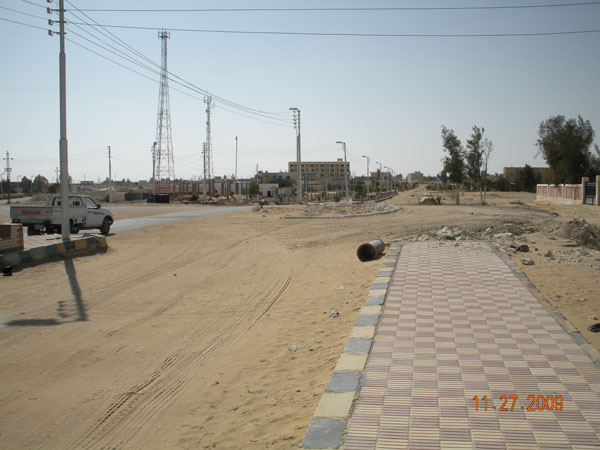
We had to wait some time for our driver to return, but he eventually showed up with another Egyptian man, dark, rather short and very quiet, who sat next to Abd Allah in the front seat. We drove a short way down the main road and into the center of town where a crossroads of sorts was the location for a larger assemblage of shops and stores that displayed articles for sale. There was a street-side restaurant—the oldest restaurant in Bahriya, one of the Egyptian women told us—and a multi-storied hotel, quite modern but looking rather baked and dessicated in the early afternoon sun. A natural rock fountain built into the side of the hotel was dry and dusty. We wandered around and noted that the prices of some items here were significantly lower than at the shop next to the restaurant we had visited. No big surprise there…
After about ten minutes of wandering (even that was about five minutes longer than one required to walk from one end of the area to the other), we continued on our way. Within ten minutes, we were back out in the desert and driving toward the Farafra Oasis, the next green spot on the map. Farafra is the smallest of the “inner oases,” according to my Blue Guide and the White Desert essentially surrounds it. We made a brief stop at our next point of interest, a roadside attraction known as the Crystal Mountain.  Hardly more than a thirty-foot mound with a small person-sized rock arch to one side, the formation is composed of quartz crystals and probably would be quite a sight in the sun after a good rain shower to wash the dust off. We wandered around the site for a few minutes, looked for crystals in the dirt of the parking area and then climbed back into the car.
Hardly more than a thirty-foot mound with a small person-sized rock arch to one side, the formation is composed of quartz crystals and probably would be quite a sight in the sun after a good rain shower to wash the dust off. We wandered around the site for a few minutes, looked for crystals in the dirt of the parking area and then climbed back into the car.
We drove for about another 100 kilometers and just short of Farafra, we spotted two four wheel Toyotas sitting on the shoulder of the road. The van pulled over and we were told that this was the final leg of our journey. The five foreigners and the quiet Egyptian man transferred to one of the Toyotas; our gear was thrown onto the roof and secured with ropes. After we arranged ourselves on the bench seats in the back, our new driver cranked up the engine and we tore off across the desert. Tracks of other four-wheel vehicles were evident but Ashari, our driver, seemed to be content to follow his own sense of direction. The sun was beginning to creep toward the horizon, but there was still plenty of light to illuminate a series of remarkable white rock formations scattered among the sands. A fifteen minute ride brought us within sight of a huddle of tents. We had arrived.
 The Toyota pulled up adjacent to the tents and we unfolded ourselves from the back. A long arcade of shelters made of dark woolen or camel hair rugs stretched along the sand on one side of the site. There was a cook tent, a couple of old wooden tables standing front it and a second arcade of open shelters beyond it. At either end of the row of tents was a tall pillar of white rock, scoured by wind and blown sand into fantastic shapes. To the west, a low white ridge of the same rock glowed in the sun. Smaller bleached formations stood all around on the horizon. In between the white rocks were expanses of sand, some deep and soft, others rippled by the wind and packed hard.
The Toyota pulled up adjacent to the tents and we unfolded ourselves from the back. A long arcade of shelters made of dark woolen or camel hair rugs stretched along the sand on one side of the site. There was a cook tent, a couple of old wooden tables standing front it and a second arcade of open shelters beyond it. At either end of the row of tents was a tall pillar of white rock, scoured by wind and blown sand into fantastic shapes. To the west, a low white ridge of the same rock glowed in the sun. Smaller bleached formations stood all around on the horizon. In between the white rocks were expanses of sand, some deep and soft, others rippled by the wind and packed hard.

We were asked whether we wanted one big tent or two small ones. The women obviously preferred to have their own shelter, so we said, “Two, please.” The camp director turned and gave some instructions to his helpers. After a brief discussion, he turned to us and said, “Too windy to put up another tent just now. Use one big one.” Ginger and Joelle assented graciously and we ducked into a large wall tent easily twenty feet square. Inside, rush mats had been placed over the sand on either side of the entry with a bare sand path down the center. The three guys plunked their gear down on one side and the two women theirs on the other. Jamie went out and asked about the promised mattresses and in short order a large canvas bag containing five foam mattresses, each about two inches thick, was delivered and we spread them out. “Blankets?” We asked. Oh yeah, Blankets. They’re coming from Farafra, we’re told. They’ll be here soon.
There was just time before the sun set to do a bit of exploring and to get our bearings, as best we could in a remote and inhospitable place. There was a port-a-potty tucked behind one of the larger rock formations at a discrete distance from the tents, as well as a port-a-shower, connected to a tank of water set on a ledge above the structure by a plastic pipe. Nearby an electrical generator sat silently on the sand. A cord, intermittently visible in the sand, ran across the desert toward the tents. All the mod-cons one could ask for.
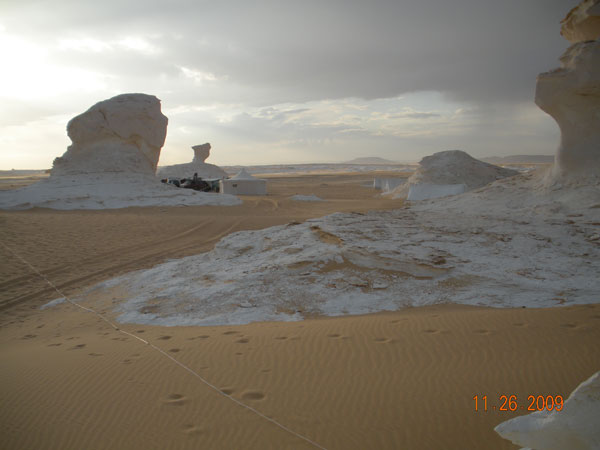
The sun was disappearing behind the white ridge by now and the wind, blowing strongly when we first arrived, had dropped to a whisper. I pulled out my fleece and put it on; it was already getting a little cool. A couple of the expedition’s staff were busy preparing dinner and the camp began to bustle as a group of Egyptians in their private 4×4’s arrived and began to set up their own tents behind ours, or to claim one of the vacant wall tents scattered about. By nightfall, we number about thirty or thirty-five people in all, including adults, young children, and teenagers. The sun dropped below the horizon and the generator was cranked to life. Energy-saving bulbs strung on a single wire warmed up and dispensed light the shade of moonglow around the encampment.
Dinner was produced by the chef, attired for the occasion in a white chef’s coat with silver buttons. A huge pot of rice, a combination of white and yellow grains flavored with spices, chicken grilled over a campfire, as well as sliced beef in a sauce for those serious carnivores among us. There was also a salad of chopped tomatoes and cucumbers with tahina sauce. We found places on rugs and rush mats spread on the ground under the arcade and got busy with our meals. It was either very good or we were very hungry. Probably a bit of both. The rice dish and the salad beckoned for a second visit. A second campfire was going in front of the tent arcade and after the meal we relaxed with cups of tea or Nescafe in its warmth.
The stars were out and so numerous that I was unable to distinguish the Big Dipper, the one constellation I am always sure of finding. Orion was creeping up out of the east, so I could orient myself, but still no luck. Another group of Americans had arrived at some point and were projecting sketches of computer generated drawings on the face of one of the white rock formations. A surreal addition to the evening. We chatted for a while and listened to the silence. A camel brayed from some distance away and I realized that we were probably not as removed from other humans as we appeared to be. But the dark and the silence of this vast desert has the effect of making one feel quite small, insignificant and alone.
The promised blankets had arrived at some point, big, heavy camel hair or wool affairs with geometric patterns worked into the weft. More rug than blanket, they were scratchy and coarse. I was glad I had brought the sheet along; that would keep the roughness at bay. One by one we crawled off to our mattresses and, shedding only boots and jackets, got horizontal under the hefty blankets. It was like sleeping with someone on top of you, but it did keep out the cold. The mattress wasn’t quite thick enough to keep my hips off the ground and I could feel the lumps in the sand underneath it. Despite all that, I soon fell asleep.
 There were a few high clouds in the sky but they weren’t thick enough to block the sunlight. The camp was still relatively quiet at this early hour. The music the previous evening had gone on until almost midnight and many people were sleeping in, if they could. The chef was up and slowly getting breakfast on the table. Someone was stirring a campfire to life. The campsite was beginning to look a little shopworn; bits of litter peeked from the sand here and there; the port-a-potty was filling up; the chef’s white jacket was smudged with grease and soot. Nonetheless, there was soon hot water for tea and Nescafe and the day looked a bit brighter after a cup or two.
There were a few high clouds in the sky but they weren’t thick enough to block the sunlight. The camp was still relatively quiet at this early hour. The music the previous evening had gone on until almost midnight and many people were sleeping in, if they could. The chef was up and slowly getting breakfast on the table. Someone was stirring a campfire to life. The campsite was beginning to look a little shopworn; bits of litter peeked from the sand here and there; the port-a-potty was filling up; the chef’s white jacket was smudged with grease and soot. Nonetheless, there was soon hot water for tea and Nescafe and the day looked a bit brighter after a cup or two.

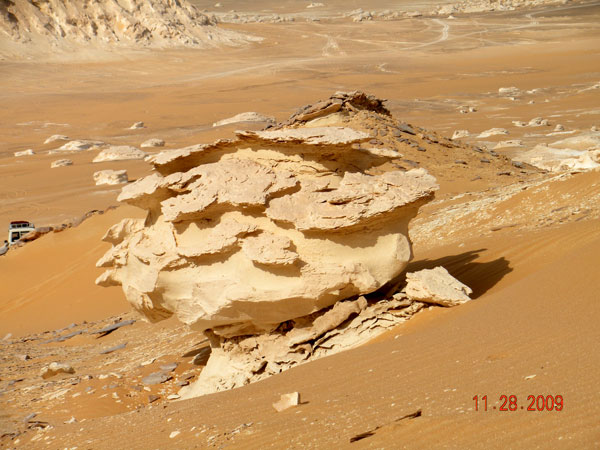
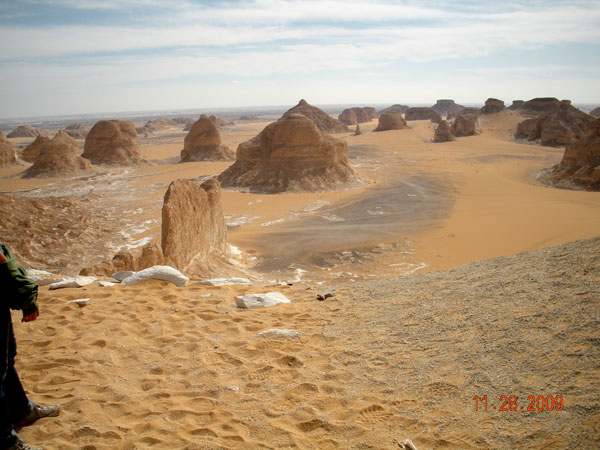
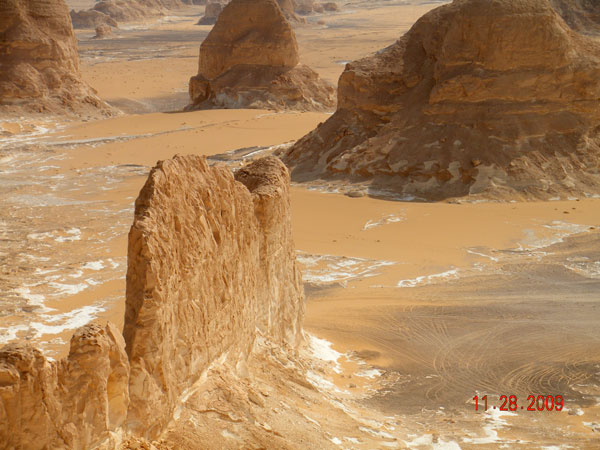

 At each stop we competed with each other in discovering the most unusual example. Ginger returned to Cairo with a pack weighing twice what it did when she set out. There were places where the black rocks stuck up out of the white stone like mails in a piece of wood; frequently, on exposed rock faces, the black stones were visible, embedded in the chalk. This material must have rained down on the ancient sea and, cooling as it sank, stuck into the still soft sediment at the sea bottom where it was eventually covered by eons of crustaceous carcasses. Elsewhere, we found the remnants of ancient seashells embedded in the chalk as well. Some of the black stones even bore the impressions of seashells. Glad I wasn’t around for that “weather event.”
At each stop we competed with each other in discovering the most unusual example. Ginger returned to Cairo with a pack weighing twice what it did when she set out. There were places where the black rocks stuck up out of the white stone like mails in a piece of wood; frequently, on exposed rock faces, the black stones were visible, embedded in the chalk. This material must have rained down on the ancient sea and, cooling as it sank, stuck into the still soft sediment at the sea bottom where it was eventually covered by eons of crustaceous carcasses. Elsewhere, we found the remnants of ancient seashells embedded in the chalk as well. Some of the black stones even bore the impressions of seashells. Glad I wasn’t around for that “weather event.” We continued driving through the depression, entering a flat area with row upon row of white stone pillars which we had to slalom our way through. At times I doubted Ashari’s sense of distances as we squeezed through gaps that I feared would leave us jammed between two walls of rock, but he piloted us through without so much as a scratch on the doors. t a relatively open space, he stopped and let us out to take some photos and explore a bit. Within minutes, Jamie had disappeared and I saw how easily one could become disoriented and lost in this place. The rock formations were ever-changing; there were several in this spot that looked like nothing so much as a piece of mille feuille pastry drizzled with a sugary icing. More wondering about what sort of geological process had created such masterpieces. Every turn revealed something new and surprising.
We continued driving through the depression, entering a flat area with row upon row of white stone pillars which we had to slalom our way through. At times I doubted Ashari’s sense of distances as we squeezed through gaps that I feared would leave us jammed between two walls of rock, but he piloted us through without so much as a scratch on the doors. t a relatively open space, he stopped and let us out to take some photos and explore a bit. Within minutes, Jamie had disappeared and I saw how easily one could become disoriented and lost in this place. The rock formations were ever-changing; there were several in this spot that looked like nothing so much as a piece of mille feuille pastry drizzled with a sugary icing. More wondering about what sort of geological process had created such masterpieces. Every turn revealed something new and surprising.
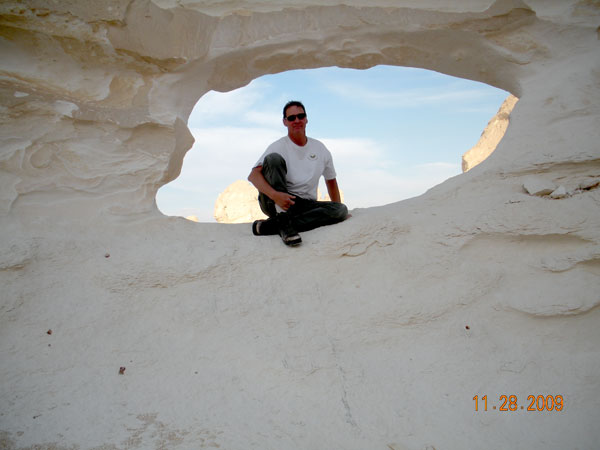
 Our penultimate stop was in a canyon surrounded by towering white cliffs. To one side was a jagged pillar of white rock easily 200 feet high; at its base was a hole that allowed us to crawl through from one side to the other. I tried to keep from my consciousness the fact that several hundreds of thousands of tons of rock sat above us. The final leg of our journey brought us up out of the basin and across the paved road to another area where white rock pillars dominated the landscape. There was again a myriad of shapes and forms stretching away, but in truth this dimmed in comparison to what we had seen earlier in the day. Still, it was an impressive way to end our tour.
Our penultimate stop was in a canyon surrounded by towering white cliffs. To one side was a jagged pillar of white rock easily 200 feet high; at its base was a hole that allowed us to crawl through from one side to the other. I tried to keep from my consciousness the fact that several hundreds of thousands of tons of rock sat above us. The final leg of our journey brought us up out of the basin and across the paved road to another area where white rock pillars dominated the landscape. There was again a myriad of shapes and forms stretching away, but in truth this dimmed in comparison to what we had seen earlier in the day. Still, it was an impressive way to end our tour.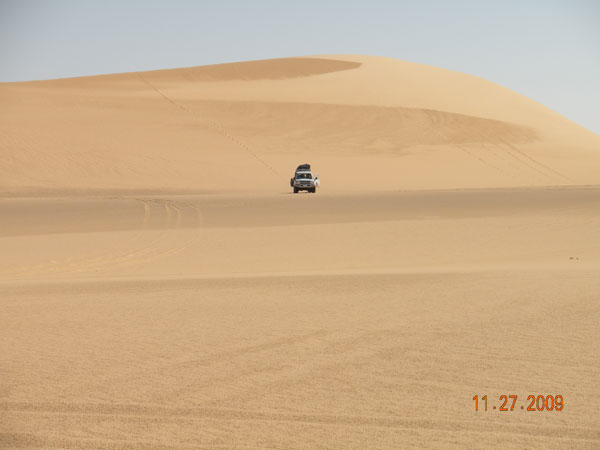
 From the backs of two of the expedition vehicles snowboards were produced and everyone headed up the slope of the dune for some sand skiing. The kids, of course were the most enthusiastic and adventurous. The bottoms of the boards were coated with formica, which was meant to make them slippery on the sand. They worked reasonably well, but except for the most precipitous slope near the end of the dune, no breathtaking speeds were achieved. We spent a good hour during which everyone had at least one ride down the dune. I felt like a real Americano tourist, but really, how many chances does one get to do that? Of course there was one testosterone powered idiot who had to prove his car was the most powerful machine ever built and he drove to the crest of the dune, receiving the cheers of his fellow SUV owners. The cheers quickly died however, when the car sank into the sand. He and his friends spent forty-five minutes digging and shifting a pair of sand sheets under various wheels until he finally managed to get free. Sometimes guys are SO predictable.
From the backs of two of the expedition vehicles snowboards were produced and everyone headed up the slope of the dune for some sand skiing. The kids, of course were the most enthusiastic and adventurous. The bottoms of the boards were coated with formica, which was meant to make them slippery on the sand. They worked reasonably well, but except for the most precipitous slope near the end of the dune, no breathtaking speeds were achieved. We spent a good hour during which everyone had at least one ride down the dune. I felt like a real Americano tourist, but really, how many chances does one get to do that? Of course there was one testosterone powered idiot who had to prove his car was the most powerful machine ever built and he drove to the crest of the dune, receiving the cheers of his fellow SUV owners. The cheers quickly died however, when the car sank into the sand. He and his friends spent forty-five minutes digging and shifting a pair of sand sheets under various wheels until he finally managed to get free. Sometimes guys are SO predictable.

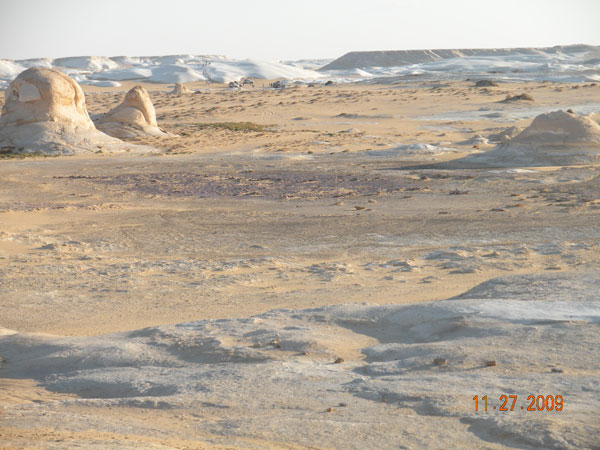



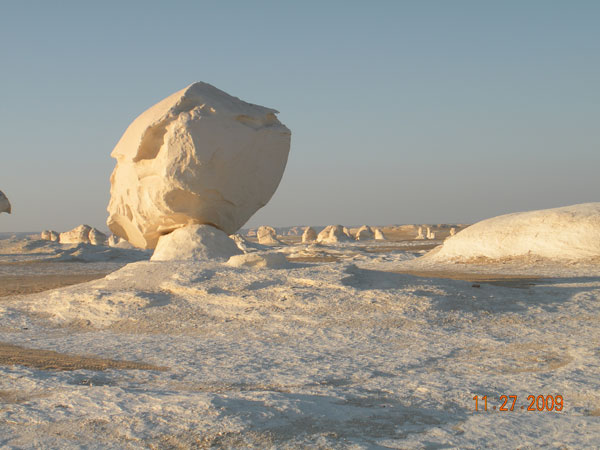 The sun was settling toward the horizon as we reached our last stop of the day. One of the most famous areas of the White Desert contains chalk formations shaped by the winds into marvelous figures. This particular location was known as the Mushrooms and there were indeed several that looked for all the world like fungi, but the variety of shapes was endless. One was also struck by the fragility of these monuments, for everywhere one could see where huge chunks of rock had recently fallen away, splitting along fracture lines and shattering into smaller pieces as they struck the ground. I realized that what we were seeing was a snapshot of what was and what would be. Visitors to this same place in two years time—perhaps less—would see something quite different.
The sun was settling toward the horizon as we reached our last stop of the day. One of the most famous areas of the White Desert contains chalk formations shaped by the winds into marvelous figures. This particular location was known as the Mushrooms and there were indeed several that looked for all the world like fungi, but the variety of shapes was endless. One was also struck by the fragility of these monuments, for everywhere one could see where huge chunks of rock had recently fallen away, splitting along fracture lines and shattering into smaller pieces as they struck the ground. I realized that what we were seeing was a snapshot of what was and what would be. Visitors to this same place in two years time—perhaps less—would see something quite different.
 After about two hours, the road dropped into a major depression in the earth; we descended several hundred feet over several miles on a graded roadbed. The escarpment of the depression was visible as a series of cliffs off to the north. These depressions were where we would find the oases that provided small groups of people with a tenuous grip on life here amidst all this aridity. There is a string of such depressions across the desert here that hold what are called the “Inner Oases,” Bahriya, Farafra, Dakhla, and Siwa a bit to the north. Our first stop was Bahriya, where we had to pass through a checkpoint manned by the police. We stopped and our driver was asked how many foreigners he had with him and what our nationalities were. One of the Egyptian women translated and we relayed the requested information to the cops. Our driver, Abd Allah, was obviously known to them because there was a lengthy conversation, an exchange of news, before we resumed our travel.
After about two hours, the road dropped into a major depression in the earth; we descended several hundred feet over several miles on a graded roadbed. The escarpment of the depression was visible as a series of cliffs off to the north. These depressions were where we would find the oases that provided small groups of people with a tenuous grip on life here amidst all this aridity. There is a string of such depressions across the desert here that hold what are called the “Inner Oases,” Bahriya, Farafra, Dakhla, and Siwa a bit to the north. Our first stop was Bahriya, where we had to pass through a checkpoint manned by the police. We stopped and our driver was asked how many foreigners he had with him and what our nationalities were. One of the Egyptian women translated and we relayed the requested information to the cops. Our driver, Abd Allah, was obviously known to them because there was a lengthy conversation, an exchange of news, before we resumed our travel. The Bahriya Oasis is the “gateway” to the desert, as it were, and the road here was lined with trees that looked like poplars. Behind them were fields and groves of what looked like tropical fruit trees. Mud brick and stone houses began to appear. Within five miles, we were in the oasis proper and we had to make another stop. Here, in front of the main police station, our passports were collected and we were then transported about five hundred yards down the road and dumped off at a restaurant where several locals sat drinking tea and smoking shishas in the shade of an aluminum awning. Thankfully, the comfort facilities here were respectable and the restaurant itself clean and quiet. We ordered tea and sat at a table.
The Bahriya Oasis is the “gateway” to the desert, as it were, and the road here was lined with trees that looked like poplars. Behind them were fields and groves of what looked like tropical fruit trees. Mud brick and stone houses began to appear. Within five miles, we were in the oasis proper and we had to make another stop. Here, in front of the main police station, our passports were collected and we were then transported about five hundred yards down the road and dumped off at a restaurant where several locals sat drinking tea and smoking shishas in the shade of an aluminum awning. Thankfully, the comfort facilities here were respectable and the restaurant itself clean and quiet. We ordered tea and sat at a table.
 Hardly more than a thirty-foot mound with a small person-sized rock arch to one side, the formation is composed of quartz crystals and probably would be quite a sight in the sun after a good rain shower to wash the dust off. We wandered around the site for a few minutes, looked for crystals in the dirt of the parking area and then climbed back into the car.
Hardly more than a thirty-foot mound with a small person-sized rock arch to one side, the formation is composed of quartz crystals and probably would be quite a sight in the sun after a good rain shower to wash the dust off. We wandered around the site for a few minutes, looked for crystals in the dirt of the parking area and then climbed back into the car. The Toyota pulled up adjacent to the tents and we unfolded ourselves from the back. A long arcade of shelters made of dark woolen or camel hair rugs stretched along the sand on one side of the site. There was a cook tent, a couple of old wooden tables standing front it and a second arcade of open shelters beyond it. At either end of the row of tents was a tall pillar of white rock, scoured by wind and blown sand into fantastic shapes. To the west, a low white ridge of the same rock glowed in the sun. Smaller bleached formations stood all around on the horizon. In between the white rocks were expanses of sand, some deep and soft, others rippled by the wind and packed hard.
The Toyota pulled up adjacent to the tents and we unfolded ourselves from the back. A long arcade of shelters made of dark woolen or camel hair rugs stretched along the sand on one side of the site. There was a cook tent, a couple of old wooden tables standing front it and a second arcade of open shelters beyond it. At either end of the row of tents was a tall pillar of white rock, scoured by wind and blown sand into fantastic shapes. To the west, a low white ridge of the same rock glowed in the sun. Smaller bleached formations stood all around on the horizon. In between the white rocks were expanses of sand, some deep and soft, others rippled by the wind and packed hard.

 We set off through Cairo traffic, which was beginning to build at that hour. It took us a good hour to clear Cairo and then we were on the four-lane headed south toward the Fayyoum. I had ridden this same road earlier in the month when I visited Karanis so I busied myself with breakfast and chatting with my travel mates: Virginia da Costa, Dominique Ellis, Breonna Arder, and Joe Yackley, our newest member who is pursuing dissertation research in Egypt and Turkey later on. The Toyota we were in was not the newest ride on the road and had obviously seen some rough cross country travel. The suspension was stiff and that, combined with a short wheel base, made for a rough journey, even on the paved road. To add to our discomfort, Dominique and Breonna, who had chosen to ride in the rear seats, had to deal with gasoline fumes. For this reason as well as to give people different conversation partners, we switched seats occasionally.
We set off through Cairo traffic, which was beginning to build at that hour. It took us a good hour to clear Cairo and then we were on the four-lane headed south toward the Fayyoum. I had ridden this same road earlier in the month when I visited Karanis so I busied myself with breakfast and chatting with my travel mates: Virginia da Costa, Dominique Ellis, Breonna Arder, and Joe Yackley, our newest member who is pursuing dissertation research in Egypt and Turkey later on. The Toyota we were in was not the newest ride on the road and had obviously seen some rough cross country travel. The suspension was stiff and that, combined with a short wheel base, made for a rough journey, even on the paved road. To add to our discomfort, Dominique and Breonna, who had chosen to ride in the rear seats, had to deal with gasoline fumes. For this reason as well as to give people different conversation partners, we switched seats occasionally. Before long, we were nearing the turnoff for the Fayyoum oasis. I saw the Karanis excavation off to the left of the road and knew we were getting near.
Before long, we were nearing the turnoff for the Fayyoum oasis. I saw the Karanis excavation off to the left of the road and knew we were getting near. 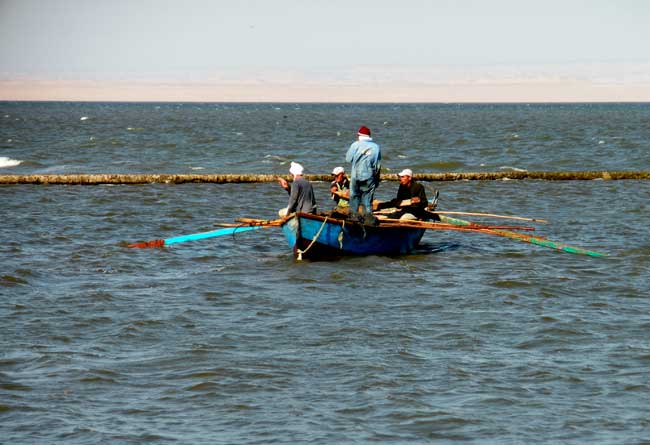
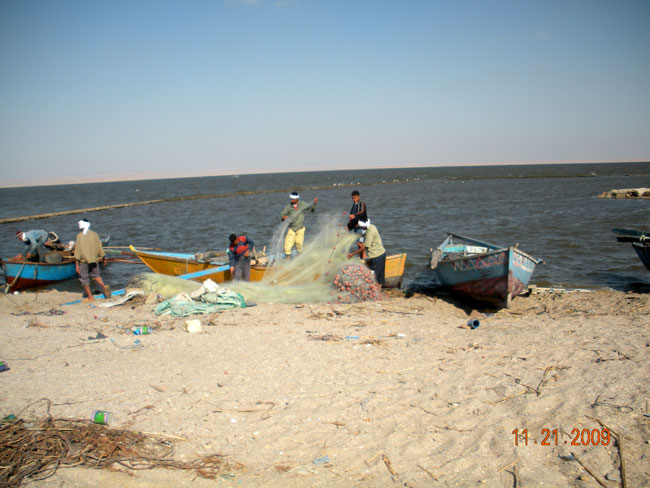
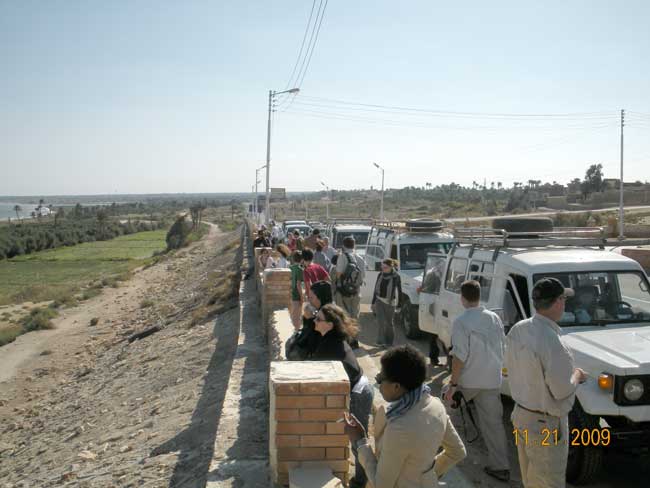 We made a brief stop so that people could take photos and then continued our journey. Our destination was an archeological excavation in a geographical feature called Wadi al-Hitan or the Valley of the Whales. Yes, in the desert, there is a place where one can see what’s left of whales. Of course they are forty-million-year-old whales but they are (or were) whales. One species in particular, the Basilosaurus, is found only here and its importance to paleontologists and those who study evolution lies in the fact that they had vestigial feet. In other words, whales were once land dwellers who decided that the ocean offered a better living and returned to the primordial soup as it were.
We made a brief stop so that people could take photos and then continued our journey. Our destination was an archeological excavation in a geographical feature called Wadi al-Hitan or the Valley of the Whales. Yes, in the desert, there is a place where one can see what’s left of whales. Of course they are forty-million-year-old whales but they are (or were) whales. One species in particular, the Basilosaurus, is found only here and its importance to paleontologists and those who study evolution lies in the fact that they had vestigial feet. In other words, whales were once land dwellers who decided that the ocean offered a better living and returned to the primordial soup as it were. We arrived at the visitors’ center and alighted from the trucks. We walked about for a few minutes to work the kinks out and take in the landscape. The area reminded me of the desert southwest in the States, but without the variety of colors. Still, the rock formations were impressive, having been sculpted by the sand and the wind over untold millennia. We gathered at one of the buildings and received a brief orientation from the head paleontologist who explained the geology of the region and the importance of the site. He explained that there were there distinct geological layers found here representing a cross-section of several tens of millions of years. Whales continued to live here during all of that time until the Earth’s climate began to cool and the polar ice caps formed, pulling liquid water away from the planet’s girth. Now it looks as though we’re reversing course once again. The paleontologist also showed us some fossilized remains of the whales and explained how they came to be preserved. The remains were covered quickly by silt or sand and the soft tissues decayed quickly. That allowed the minerals in the water and earth to replace the organic material of the skeletons and fossilize them.
We arrived at the visitors’ center and alighted from the trucks. We walked about for a few minutes to work the kinks out and take in the landscape. The area reminded me of the desert southwest in the States, but without the variety of colors. Still, the rock formations were impressive, having been sculpted by the sand and the wind over untold millennia. We gathered at one of the buildings and received a brief orientation from the head paleontologist who explained the geology of the region and the importance of the site. He explained that there were there distinct geological layers found here representing a cross-section of several tens of millions of years. Whales continued to live here during all of that time until the Earth’s climate began to cool and the polar ice caps formed, pulling liquid water away from the planet’s girth. Now it looks as though we’re reversing course once again. The paleontologist also showed us some fossilized remains of the whales and explained how they came to be preserved. The remains were covered quickly by silt or sand and the soft tissues decayed quickly. That allowed the minerals in the water and earth to replace the organic material of the skeletons and fossilize them. The paleontologist soon led us off on a tour of the area. The path through the site was marked by stones and clay pots. At various locations, examples of the skeletons were on display. Some of the exhibits were clearly staged and the scientist acknowledged this. He said that one species in particular had a tendency to curl in death—probably due to contractions in the heavy muscles—and the scientists had straightened out the display skeletons so that people could get a clearer idea of the scale and composition of the bones. The exhibits are scattered over quite a wide area and an hour’s walk didn’t bring us anywhere near the end of the trail. In addition to animal fossils, there were interesting examples of fossilized plant remains as well. Near the mouth of an ancient river, in brackish water was a mangrove swamp; some of the tree roots had been fossilized and are now preserved in stone.
The paleontologist soon led us off on a tour of the area. The path through the site was marked by stones and clay pots. At various locations, examples of the skeletons were on display. Some of the exhibits were clearly staged and the scientist acknowledged this. He said that one species in particular had a tendency to curl in death—probably due to contractions in the heavy muscles—and the scientists had straightened out the display skeletons so that people could get a clearer idea of the scale and composition of the bones. The exhibits are scattered over quite a wide area and an hour’s walk didn’t bring us anywhere near the end of the trail. In addition to animal fossils, there were interesting examples of fossilized plant remains as well. Near the mouth of an ancient river, in brackish water was a mangrove swamp; some of the tree roots had been fossilized and are now preserved in stone.  A little distance away we saw the petrified trunk of a tree that had fallen into the ancient river and had been colonized by some sort of worm and the hole they left were then inhabited by a pencil-shaped bi-valve and their remains were fossilized also.
A little distance away we saw the petrified trunk of a tree that had fallen into the ancient river and had been colonized by some sort of worm and the hole they left were then inhabited by a pencil-shaped bi-valve and their remains were fossilized also. After fruit and tea, we saddled up again and left the area, driving back on the same dirt track. On the way back, we stopped at another geologically important area dominated by two round mountains rising against an artificial lake in the background. Here we stopped for a brief photo opportunity and a chance to pick up some fossils. The ground was covered by small disc-shaped stones ranging from dime to quarter size and varying in color from sand to light pink. These are the fossilized remains of a forty-million year-old single-cell animal from the order foraminifera. The locals call them “ancient coins.”
After fruit and tea, we saddled up again and left the area, driving back on the same dirt track. On the way back, we stopped at another geologically important area dominated by two round mountains rising against an artificial lake in the background. Here we stopped for a brief photo opportunity and a chance to pick up some fossils. The ground was covered by small disc-shaped stones ranging from dime to quarter size and varying in color from sand to light pink. These are the fossilized remains of a forty-million year-old single-cell animal from the order foraminifera. The locals call them “ancient coins.”